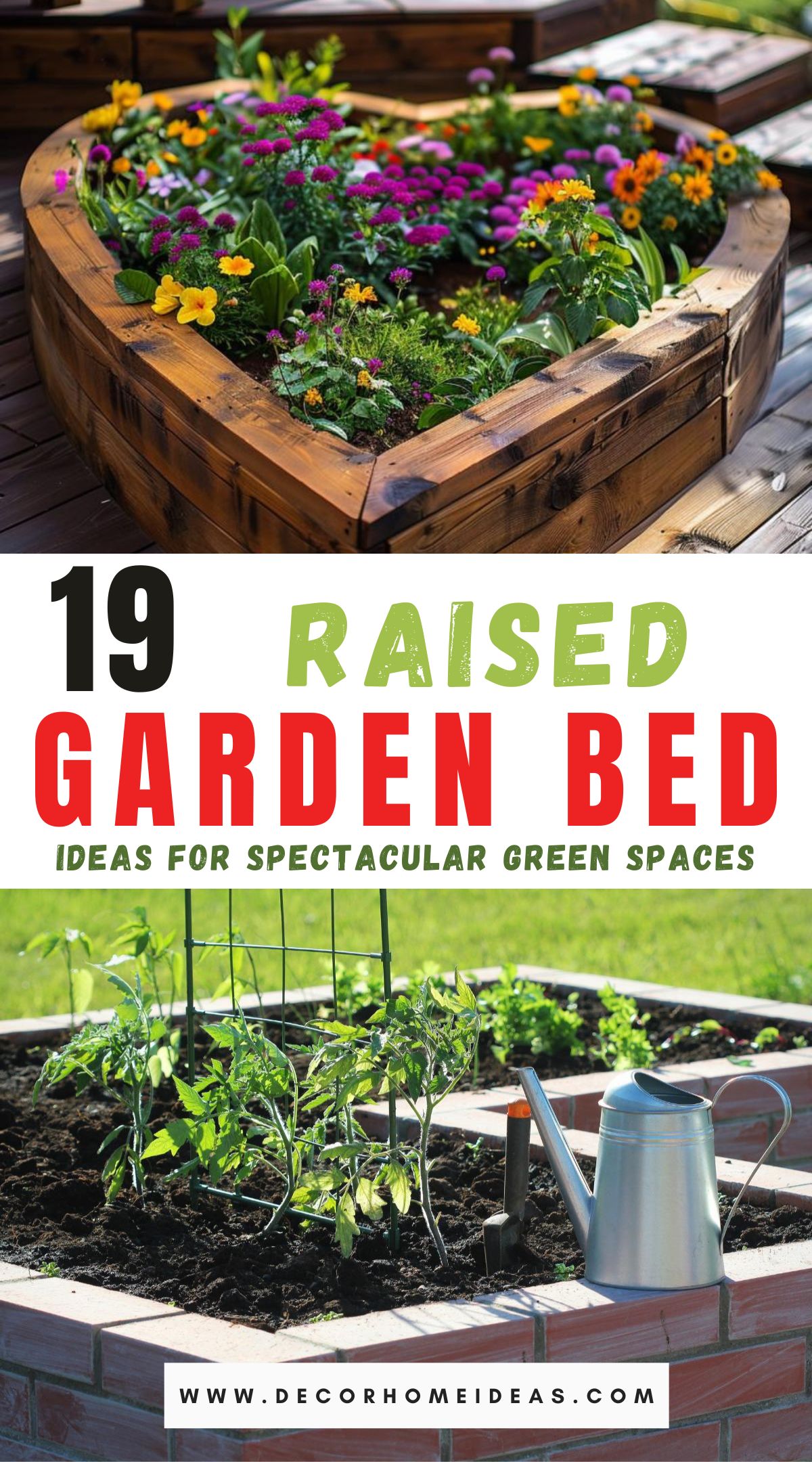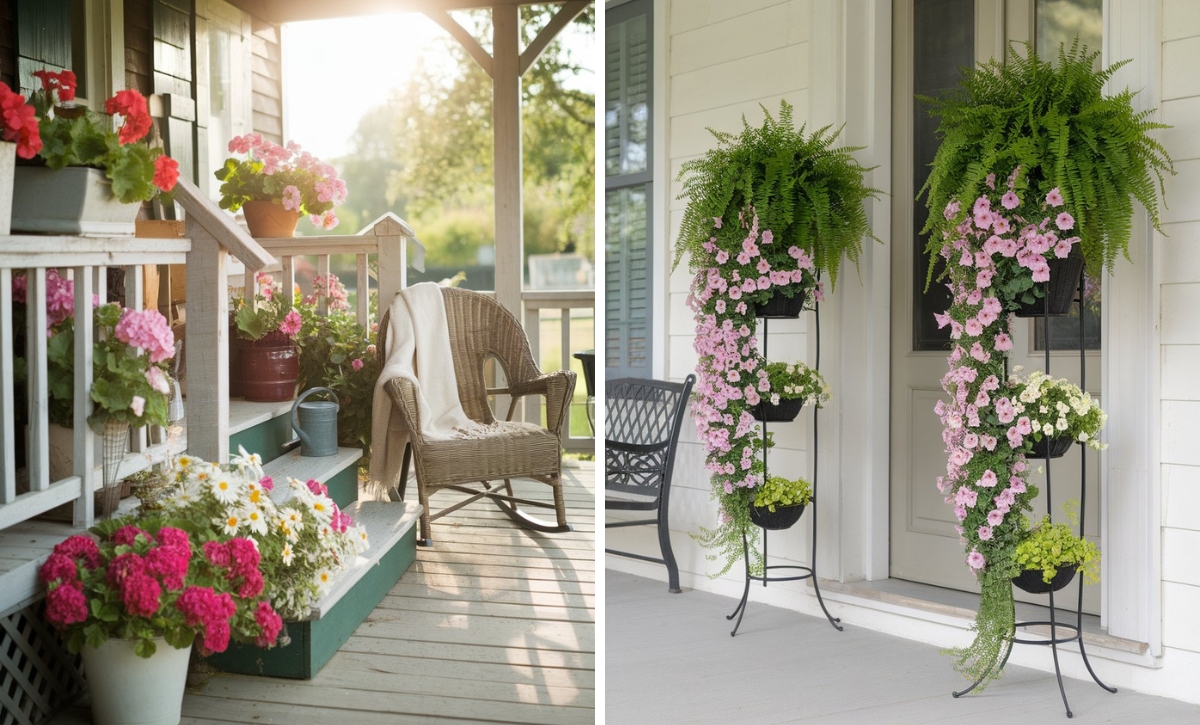A raised garden bed may be the haven you’re looking for for your kitchen.
The good thing about raised beds is that they can be permanent or temporary fixtures, so you don’t have to worry about the commitment.
Besides, raised beds can also have an artistic element to them, so they will definitely improve the aesthetic appeal of your home.

The good thing about these gardens is that you can get as creative as you like with them and use various materials, from wood, stone, brick, or even upcycled materials.
We’ve compiled 19 remarkable raised garden bed ideas to transform your outdoors and uplift curb appeal.
Take a look!
1. Wooden Patterned Raised Bed

Wood is one of the best materials to make a raised garden bed, and in this design, it’s used to create a partnered raised garden bed that’s easy to access from all areas.
The height makes the garden easy to tend to, with no need to strain your back to reach the plants.
2. Sectional Garden

Dividing the garden into a small square garden is one way to increase the surface area and create a productive kitchen garden.
A sectioned garden will also do wonders for your aesthetic appeal since you can use different to divide the garden.
In this raised garden bed, the sectional garden adds a touch of greenery to the space, making it easy to control the garden’s soil quality.
3. Multi-Level Raised Garden Bed

A multi-level raised garden bed is the perfect solution for growing different vegetables you don’t want to mix up in your garden.
It can also allow you to grow plants in different stages to have a fresh supply of vegetables all year long, like in this raised garden bed.
4. Bricks and Cobblestone

Old is gold, and bricks and cobblestone have been used for centuries, so they are proven raised garden bed material that can withstand the test of time.
You can section the garden to allow you to grow various plants. To increase the stability of the raised bed, use a double brick wall with stones all around.
While using mortar isn’t completely necessary, you can use masonry adhesive to hold the wall together, especially if you’re building a tall, raised bed.
5. Floating Raised Garden Bed

One of the advantages of a raised garden bed is reducing the risk of disease and pest infestation.
The designer uses wood to create a floating garden in this creative garden. This shields the plants on the bed from most pests and diseases they’ll be susceptible to on the ground.
6. Garden within a Garden

Some plants will only survive if they have closely controlled growing conditions, and raised garden beds are the perfect solution.
The owners incorporate a raised garden bed in this design to accommodate vegetables. This works well if you need to monitor the conditions of some plants closely or if you have limited resources such as fertilizer.
7. Trough Garden

Animal troughs make excellent garden beds. They are simple to use, and you don’t have to worry about any kind of assembly. You only need to add some drainage holes at the bottom, and you are good to go.
Despite being simple troughs, give your garden a unique mechanical look. However, you’ll have to consider the plant’s watering needs, especially in the summer, since steel is a good heat conductor.
8. Create an Oasis

Temperatures and the soil type can sometimes be disheartening when you want to grow a garden. Moreover, preparing large tracts of land can take time, not to mention difficult to manage.
This raised garden bed breathes life into the space despite the challenging environment. Its small size makes it easy to tend to.
9. Raised Bed for Your Whole Yard

If the soil and the climate are favorable, there’s no reason you shouldn’t create a raised bed to cover the entire space.
In this design, the raised beds are carefully crafted to span the entire yard with clear, distinguished walkways that allow you to marvel at the garden’s beauty.
10. Elevated Bricks

There are many reasons for creating raised garden beds, but easing the gardening process is one of my top reasons.
Gardening is a high-effort activity, and this may be exacerbated if you have back problems, but with a raised garden bed, you won’t have to struggle that much.
In this design, bricks elevate the bed, making gardening a breeze.
11. Add Some Spiral Flair

One of the most famous permaculture techniques is using spiral gardens. These gardens increase the surface area for gardening without taking up more space, making them ideal where space is an issue.
You can use various materials to create a spiral garden, from metal, bricks, or even wood. In this design, the spiral garden acts as a focal point while the herbs grown add to the flair.
12. Succulent Paradise

D-CRAIN Design and Construction
You can use raised garden beds to create a garden that’s an oasis in areas with challenging climatic conditions, but you can also use them to create a mini desert; growing conditions on garden beds are easy to manipulate.
This design features raised garden beds to create a succulent garden that adds a sense of uniqueness to the space.
13. Add Architectural Flair

Raised garden beds allow you to get as creative as possible. In this design, the sky’s the limit, with the raised beds mirroring a construction site.
Here, the design isn’t only aesthetically pleasing but also functional.
Using stone and metal minimizes the chances of the plants getting attacked by vicious pests such as termites that can cause extensive damage.
14. Floating Containers

The only limit when working with raised garden beds is your imagination.
This design uses large trough containers to create a raised garden with a well-structured support system that makes the garden seem floating.
When using such a design, it’s essential to consider the weight of the soil and plants growing on the bed before designing the support system.
15. Raised Bed for Delicate Plants

Anyone with enough gardening experience understands how delicate some plants can be.
Plants that need extra care and attention from natural elements such as the sun, wind, or even rain may benefit from a raised garden bed.
This covered raised garden bed serves to protect the delicate plants growing within. The translucent cover allows enough light to reach the plants even when the bed is covered.
It also provides for the creation of a greenhouse climate that benefits the plants.
16. Isolated Garden

Weeds are a nuisance in any garden, and creating a garden in a space prone to or infested with weeds may be challenging. However, a raised garden bed offers a great solution to the problem.
This design uses a raised garden bed to create a distinguished place to grow vegetables isolated from the rest of the garden.
This reduces the risk of weeds creeping into the garden and impacting the crops.
17. A Crate Garden

Repurposing old items is one of the best ways to set up a raised garden bed. In this design, crates have been used as the primary form of the raised garden bed.
What makes such a design interesting is its portability. This is the way to go if you have plants that need to be shielded from the sun occasionally.
All you need to do is pick up the crate and place it in a shaded area, and since the crates are already porous, you don’t need to add drainage walls.
18. Use Your Sloping Yard

For a challenging landscape, raised garden beds offer a solution to utilize the space, especially on slopes. This design uses repurposed concrete to create a chef’s garden in a sloping landscape.
Wood and concrete create an excellent barrier to hold the soil, while the multi-level design allows different crops to be grown in each section.
19. Backyard with Raised Garden Beds

Raised garden beds are a fantastic landscaping solution in small spaces. Since you can vary the height of the raised garden beds, you can easily use them to create an exciting landscape design.
In this farmhouse landscape, the raised garden points are the center of the design, with varying raised garden bed designs creating an interesting visual pattern.
20. Heart Shaped Raised Garden Bed

This heart-shaped raised garden bed brings a romantic touch to outdoor spaces. Crafted from rich, rustic wood with a smooth finish, it highlights a lively mix of colorful flowers like daisies, marigolds, and zinnias.
The vibrant purples, yellows, and oranges contrast beautifully with the natural tones of the wooden structure, creating a warm and inviting ambiance.
Positioned on a polished wooden deck, this design seamlessly blends natural beauty with thoughtful craftsmanship, perfect for creating a serene retreat.









